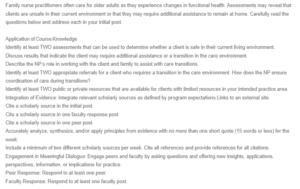Assessments to Determine Whether a Client Is Safe in Their Current Living Environment
The Activities of Daily Living (ADL) assessment and the Instrumental Activities of Daily Living (IADL) evaluation are two assessments that can be used to establish whether a client is safe in their present living situation. The ADL test assesses a person’s ability to do fundamental self-care chores such as washing, dressing, toileting, grooming, and feeding (Chen et al., 2023). On the other hand, the IADL examination examines more complicated activities like cooking, medication management, shopping, housekeeping, and transportation. If the client exhibits substantial weaknesses or dependency in these assessments, it may signal the need for extra support or a change in the care setting.
The nurse practitioner (NP) is pivotal in facilitating care transitions for clients and their families. The NP evaluates the client’s physical, psychological, and social needs to determine the best care environment, whether moving from home to a nursing facility, assisted living, or receiving home health care. The NP works closely with the client and their family to ensure their preferences and concerns are considered in decision-making (Casey et al., 2023). Two appropriate recommendations are connecting the client with a geriatric care manager for comprehensive care planning and arranging for a home safety assessment by an occupational therapist to address potential dangers. The nurse practitioner’s responsibility in coordinating care transitions includes supervising the transfer of medical records, medication management, and providing information and emotional support to the client and family to smooth the transition process, eventually guaranteeing continuity and quality of care.
The Elder Affairs Program, administered by the Florida Department of Elder Affairs, provides a wide range of services and support for older adults, including information on long-term care options and financial assistance programs, and is available in Mount Dora, Florida, for clients with limited resources. Another option is the local Area Agency on Aging, which provides feeding programs, transportation aid, and caregiver support.
References
Casey, H., Trayer, Á., Desmond, D., & Coffey, L. (2023). Experiences and perceptions of everyday decision-making in the lives of adults with intellectual disabilities, their care partners and direct care support workers. Journal of Intellectual Disabilities. https://doi.org/10.1177/17446295231189020
Chen, D., Jutkowitz, E., & Gross, A. L. (2023). Statistical harmonization of everyday functioning and dementia‐related behavioral measures across nine surveys and trials. Alzheimer’s & Dementia: Diagnosis, Assessment & Disease Monitoring, 15(1). https://doi.org/10.1002/dad2.12412
ORDER A PLAGIARISM-FREE PAPER HERE
We’ll write everything from scratch
Question

Whether a Client Is Safe in Their Current Living Environment
Family nurse practitioners often care for older adults as they experience changes in functional health. Assessments may reveal that clients are unsafe in their current environment or that they may require additional assistance to remain at home. Carefully read the questions below and address each in your initial post.
Application of Course Knowledge
Identify at least TWO assessments that can be used to determine whether a client is safe in their current living environment.
Discuss results that indicate the client may require additional assistance or a transition in the care environment.
Describe the NP’s role in working with the client and family to assist with care transitions.
Identify at least TWO appropriate referrals for a client who requires a transition in the care environment. How does the NP ensure coordination of care during transitions?
Identify at least TWO public or private resources that are available for clients with limited resources in your intended practice area.
Integration of Evidence: Integrate relevant scholarly sources as defined by program expectations.Links to an external site.
Cite a scholarly source in the initial post.
Cite a scholarly source in one faculty response post.
Cite a scholarly source in one peer post.
Accurately analyze, synthesize, and/or apply principles from evidence with no more than one short quote (15 words or less) for the week.
Include a minimum of two different scholarly sources per week. Cite all references and provide references for all citations.
Engagement in Meaningful Dialogue: Engage peers and faculty by asking questions and offering new insights, applications, perspectives, information, or implications for practice.
Peer Response: Respond to at least one peer.
Faculty Response: Respond to at least one faculty post.


